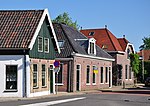Groene Hart

The Groene Hart (Dutch pronunciation: [ˈxrunə ˈɦɑrt]; English: Green Heart) is a relatively thinly populated area of the Netherlands covering much of the middle portion of the Randstad megalopolis. The major Dutch cities of Rotterdam, The Hague, Leiden, Haarlem, Amsterdam and Utrecht surround this area. Cities inside the Groene Hart include Zoetermeer, Alphen aan den Rijn, Gouda, Woerden and the smaller cities of Schoonhoven, Oudewater, Haastrecht, Nieuwkoop, Montfoort, Waddinxveen, Bodegraven and Boskoop. The Groene Hart is characterised by its rural character which contrasts the urban areas around it. Agriculture, nature and recreation are the primary activities in the Groene Hart. Residents and urban visitors can often find rest and many green spaces. Mills, dikes and Dutch cows are the primary landmarks of this lowland area. Thanks to the various separated cycle paths in the Groene Hart, the area can very well be explored by bike. The Groene Hart is of major importance to consolidate the number of Dutch meadow birds. The bird species black-tailed godwit, northern lapwing and Eurasian oystercatcher can all be found in the area.
Excerpt from the Wikipedia article Groene Hart (License: CC BY-SA 3.0, Authors, Images).Groene Hart
Steekterweg, Alphen aan den Rijn
Geographical coordinates (GPS) Address Nearby Places Show on map
Geographical coordinates (GPS)
| Latitude | Longitude |
|---|---|
| N 52.1125 ° | E 4.7008333333333 ° |
Address
Steekterweg
Steekterweg
2407 BH Alphen aan den Rijn
South Holland, Netherlands
Open on Google Maps




